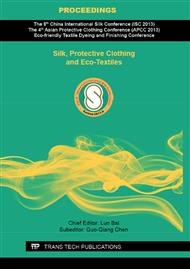p.523
p.527
p.532
p.538
p.542
p.549
p.554
p.558
p.562
Effects of the Silk Road on Chinese Fabric Pattern Design
Abstract:
After its opening, the Silk Road made its effects felt in the theme, format, and colors of pattern design of Chinese fabrics. In terms of themes, new figures of plants, animals and deity were presented. In terms of format, string of beads was originated from the western regions culture. Application and development of the gold-weaving techniques made fabric more magnificent and wealthy in color.
Info:
Periodical:
Pages:
542-548
Citation:
Online since:
September 2013
Authors:
Price:
Сopyright:
© 2013 Trans Tech Publications Ltd. All Rights Reserved
Share:
Citation:


